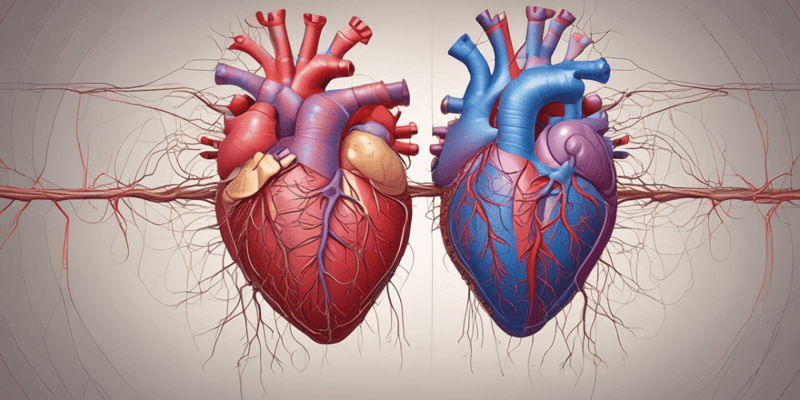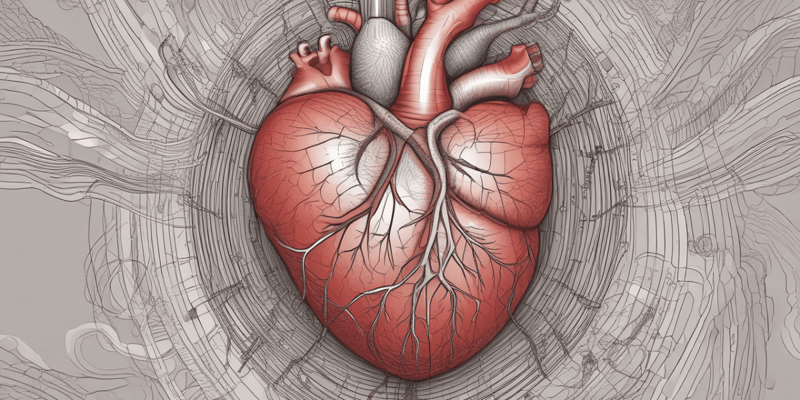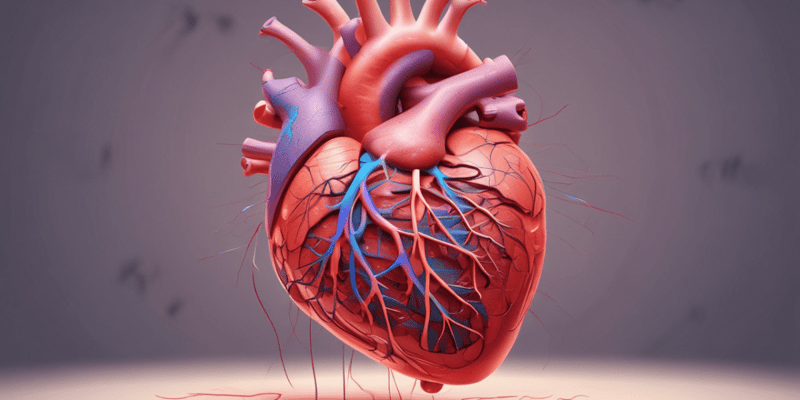10 Questions
Which part of the heart does the marginal artery supply?
Right ventricle and a portion of the lateral side of the heart
What is the function of the aortic semilunar valve in the coronary circulation?
To separate the left ventricle from the ascending aorta and prevent backflow
Which artery supplies the interventricular septum and a portion of the left and right ventricles?
Anterior interventricular artery
What is the starting point for the coronary circulation?
Left ventricle
Which vein drains deoxygenated blood into the right atrium?
Coronary sinus
What is the purpose of the coronary circulation?
To provide oxygenated blood to the myocardium
Which artery supplies the myocardium on the right side of the heart?
Right coronary artery
Where does the deoxygenated blood from the myocardium flow into after emptying into the coronary sinus?
Right atrium
What is the branch of the left coronary artery that supplies the left atrium and a portion of the left ventricle?
Circumflex artery
Which part of the heart does the posterior interventricular artery supply?
Posterior aspect of the heart
Study Notes
Coronary Circulation
- The coronary circulation is responsible for providing oxygenated blood to the myocardium of the heart.
- The coronary circulation begins in the left ventricle, where the left ventricle pumps blood through the aortic semilunar valve into the ascending aorta.
Structures Involved in Coronary Circulation
- Ascending aorta: receives blood from the left ventricle and is the starting point for the coronary circulation.
- Aortic semilunar valve: separates the left ventricle from the ascending aorta and prevents backflow.
- Right and left coronary arteries: tiny arteries that branch off from the ascending aorta to supply the myocardium with oxygenated blood.
Right Coronary Artery
- Supplies the myocardium on the right side of the heart.
- Branches off into smaller arteries, including the marginal artery and posterior interventricular artery.
- Marginal artery: supplies the right ventricle and a portion of the lateral side of the heart.
- Posterior interventricular artery: supplies the posterior aspect of the heart.
Left Coronary Artery
- Supplies the myocardium on the left side of the heart.
- Branches off into smaller arteries, including the anterior interventricular artery and circumflex artery.
- Anterior interventricular artery (also known as the left anterior descending artery): supplies the interventricular septum and a portion of the left and right ventricles.
- Circumflex artery: supplies the left atrium and a portion of the left ventricle.
Venous Return
- Deoxygenated blood from the myocardium returns to the heart through veins, including the small cardiac vein, middle cardiac vein, great cardiac vein, and posterior vein of the left ventricle.
- These veins empty into the coronary sinus, a large vein that drains deoxygenated blood into the right atrium.
- From the right atrium, blood flows into the right ventricle and then to the pulmonary circulation to pick up oxygen.
Importance of Diastole
- The myocardium receives blood supply only when the heart is in diastole (relaxation period).
- A high heart rate can impede the heart's ability to receive adequate blood supply, leading to potential problems.
Coronary Circulation
- Provides oxygenated blood to the myocardium of the heart.
Structures Involved in Coronary Circulation
- Ascending aorta: receives blood from the left ventricle and is the starting point for the coronary circulation.
- Aortic semilunar valve: separates the left ventricle from the ascending aorta and prevents backflow.
- Right and left coronary arteries: tiny arteries that branch off from the ascending aorta to supply the myocardium with oxygenated blood.
Right Coronary Artery
- Supplies the myocardium on the right side of the heart.
- Branches off into smaller arteries, including the marginal artery and posterior interventricular artery.
- Supplies the right ventricle and a portion of the lateral side of the heart through the marginal artery.
- Supplies the posterior aspect of the heart through the posterior interventricular artery.
Left Coronary Artery
- Supplies the myocardium on the left side of the heart.
- Branches off into smaller arteries, including the anterior interventricular artery and circumflex artery.
- Supplies the interventricular septum and a portion of the left and right ventricles through the anterior interventricular artery.
- Supplies the left atrium and a portion of the left ventricle through the circumflex artery.
Venous Return
- Deoxygenated blood from the myocardium returns to the heart through veins, including the small cardiac vein, middle cardiac vein, great cardiac vein, and posterior vein of the left ventricle.
- These veins empty into the coronary sinus, a large vein that drains deoxygenated blood into the right atrium.
- From the right atrium, blood flows into the right ventricle and then to the pulmonary circulation to pick up oxygen.
Importance of Diastole
- The myocardium receives blood supply only during diastole (relaxation period).
- A high heart rate can impede the heart's ability to receive adequate blood supply, leading to potential problems.
Coronary Circulation
- Provides oxygenated blood to the myocardium of the heart.
Structures Involved in Coronary Circulation
- Ascending aorta: receives blood from the left ventricle and is the starting point for the coronary circulation.
- Aortic semilunar valve: separates the left ventricle from the ascending aorta and prevents backflow.
- Right and left coronary arteries: tiny arteries that branch off from the ascending aorta to supply the myocardium with oxygenated blood.
Right Coronary Artery
- Supplies the myocardium on the right side of the heart.
- Branches off into smaller arteries, including the marginal artery and posterior interventricular artery.
- Supplies the right ventricle and a portion of the lateral side of the heart through the marginal artery.
- Supplies the posterior aspect of the heart through the posterior interventricular artery.
Left Coronary Artery
- Supplies the myocardium on the left side of the heart.
- Branches off into smaller arteries, including the anterior interventricular artery and circumflex artery.
- Supplies the interventricular septum and a portion of the left and right ventricles through the anterior interventricular artery.
- Supplies the left atrium and a portion of the left ventricle through the circumflex artery.
Venous Return
- Deoxygenated blood from the myocardium returns to the heart through veins, including the small cardiac vein, middle cardiac vein, great cardiac vein, and posterior vein of the left ventricle.
- These veins empty into the coronary sinus, a large vein that drains deoxygenated blood into the right atrium.
- From the right atrium, blood flows into the right ventricle and then to the pulmonary circulation to pick up oxygen.
Importance of Diastole
- The myocardium receives blood supply only during diastole (relaxation period).
- A high heart rate can impede the heart's ability to receive adequate blood supply, leading to potential problems.
Test your knowledge of the coronary circulation, including the structures involved and their functions, such as the ascending aorta and aortic semilunar valve.
Make Your Own Quizzes and Flashcards
Convert your notes into interactive study material.
Get started for free





